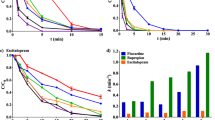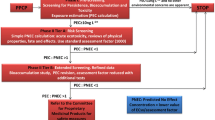Abstract
The environmental fate of transformation products from organic pollutants such as drugs has become a new research area of increasing interest over the last few years. Whereas in the past mainly parent compounds or their major human metabolites were studied, new questions have arisen what compounds could be formed during incomplete degradation in the aquatic environment and what effects the resulting transformation products might have on nature and mankind. Psychiatric drugs are among the most important prescription drugs worldwide, but so far only little data is provided upon their degradation behavior. This especially accounts for tricyclic antipsychotic drugs of the phenothiazine class. Therefore, the degradation of such drugs was investigated in this study. In this study the aerobic Closed Bottle test (The Organisation for Economic Co-operation and Development (OECD) 301D) was used to assess the ready biodegradability of three trifluoromethylated phenothiazine drugs: fluphenazine, triflupromazine, and trifluoperazine. As it is known from literature that phenothiazine drugs can easily form various photolytic transformation products under light exposure, photochemical transformation was also investigated. Since transformation products are usually not available commercially, the calculation of environmental parameters with the aid of quantitative structure activity relationship (QSAR) software was used for first evaluation of these compounds. According to the OECD test guideline, all trifluoromethylated phenothiazines had to be classified as not readily biodegradable. Chromatographic data revealed the formation of some transformation products. Comparing retention time and mass spectrometric data with the analytical results of the light exposure experiments, we found peaks with the same retention time and mass spectra. So these transformation products were not of bacterial, but photolytic, origin and are formed very quickly even under low light doses. A special chromatographic column and solvent gradient along with multiple stage mass spectrometric fragmentation experiments uncovered the presence of, in total, nine photolytic transformation products and allowed for their structural elucidation. Typical modifications of the molecules were sulfoxidation, exocyclic N-oxidation, and transformation of the trifluoromethyl to a carboxylic moiety. The obtained results of the QSAR calculations show that all transformation products are highly mobile in the aquatic environment and elimination through biotic or abiotic pathways cannot be expected. Transformation products of trifluoromethylated phenothiazine drugs have to be expected in the aquatic environment, yet nothing is known about their toxicological properties. Therefore, further risk assessment upon these drugs and their fate is strongly recommended.








Similar content being viewed by others
References
Bastianon C, Zanoni R, Miolo G et al (2005) Mitochondria and plasma membrane as targets of UVA-induced toxicity of neuroleptic drugs fluphenazine, perphenazine and thioridazine. Int J Biochem Cell Biol 37:901–908. doi:10.1016/j.biocel.2004.11.016
Boersma M, Solyanikova I, Van Berkel W et al (2001) F-19 NMR metabolomics for the elucidation of microbial degradation pathways of fluorophenols. J Ind Microbiol Biotechnol 26:22–34. doi:10.1038/sj.jim.7000027
Bohm H, Banner D, Bendels S et al (2004) Fluorine in medicinal chemistry. ChemBioChem 5:637–643. doi:10.1002/cbic.200301023
Bosca F, Cuquerella M, Marin M, Miranda M (2001) Photochemistry of 2-hydroxy-4-trifluoromethylbenzoic acid, major metabolite of the photosensitizing platelet antiaggregant drug triflusal. Photochem Photobiol 73:463–468. doi:10.1562/0031-8655(2001)0730463POHTAM2.0.CO2
Boxall A (2009) Transformation products of synthetic chemicals in the environment, 1st edn. Springer, New York
Breyer U, Gaertner HJ, Prox A (1974) Formation of identical metabolites from piperazine- and dimethylamino-substituted phenothiazine drugs in man, rat and dog. Biochem Pharmacol 23:313–322. doi:10.1016/0006-2952(74)90422-5
Burgot G, Burgot J (1990) Water/n-octanol thermodynamic parameters of some phenothiazines. Int J Pharm 62:R5–R7. doi:10.1016/0378-5173(90)90242-V
Buschmann H, Holenz J, Párraga A et al (2007) Antidepressants, antipsychotics, anxiolytics: from chemistry and pharmacology to clinical application, 1. Wiley, Weinheim
Caffieri S, Miolo G, Seraglia R et al (2007) Photoaddition of fluphenazine to nucleophiles in peptides and proteins. possible cause of immune side effects. Chem Res Toxicol 20:1470–1476. doi:10.1021/tx700123u
Ciulla TA, Epling GA, Kochevar IE (1986) Photoaddition of chlorpromazine to guanosine-5′-monophosphate. Photochem Photobiol 43:607–613. doi:10.1111/j.1751-1097.1986.tb05635.x
Dachtler M, Händel H, Glaser T et al (2000) Identification of trifluoperazine metabolites using HPLC-NMR of test mixtures. Magn Reson Chem 38:951–956. doi:10.1002/1097-458X(200011)38:11<951::AID-MRC762>3.0.CO;2-6
Eberlein-Koenig B, Bindl A, Przybilla B (1997) Phototoxic properties of neuroleptic drugs. Dermatology 194:131–135. doi:10.1159/000246080
Elisei F, Latterini L, Aloisi GG et al (2002) Excited-state properties and in vitro phototoxicity studies of three phenothiazine derivatives. Photochem Photobiol 75:11–21. doi:10.1562/0031-8655(2002)0750011ESPAIV2.0.CO2
Escher B, Baumgartner R, Lienert J, Fenner K (2009) Predicting the ecotoxicological effects of transformation products. In: Boxall A (ed) Transformation products of synthetic chemicals in the environment. Springer, Heidelberg, pp 205–244
European Commission (2003) Technical Guidance Document on Risk Assessment Part II.
Franke U, Munk A, Wiese M (1999) Ionization constants and distribution coefficients of phenothiazines and calcium channel antagonists determined by a pH-metric method and correlation with calculated partition coefficients. J Pharm Sci 88:89–95. doi:10.1021/js980206m
Gocke E (1996) Review of the genotoxic properties of chlorpromazine and related phenothiazines. Mutat Res 366:9–21. doi:10.1016/S0165-1110(96)90004-4
Harasko-van der Meer C, Bruecke T, Wenger S et al (1993) Two cases of long term dopamine D2 receptor blockade after depot neuroleptics. J Neural Transm 94:217–221. doi:10.1007/BF01277026
Heyes WF, Robinson ML (1985) HPLC procedure for the determination of some potential fluphenazine metabolites in urine. J Pharm Biomed Anal 3:477–481. doi:16/0731-7085(85)80063-7
Howard PH, Muir DCG (2010) Identifying new persistent and bioaccumulative organics among chemicals in commerce. Environ Sci Technol 44:2277–2285. doi:10.1021/es903383a
Howard PH, Muir DCG (2011) Identifying new persistent and bioaccumulative organics among chemicals in commerce II: pharmaceuticals. Environ Sci Technol 45:6938–6946. doi:10.1021/es201196x
HSDB (2011) Hazardous Substances Data Bank. US Department of Health and Human Services, National Institutes of Health, US National Library of Medicine: Bethesda, MD; http://toxnet.nlm.nih.gov/cgi-bin/sis/htmlgen?HSDB; http://toxnet.nlm.nih.gov/cgi-bin/sis/htmlgen?HSDB. Accessed 23 Feb 2012
Huber C, Krause C (2006) Instruction Manual Fibox 3 Software Version 5.32. PreSens GmbH Regensburg
Hubert-Roux M, Bounoure F, Skiba M et al (2010) Fragmentation pathways of metopimazine and its metabolite using ESI-MSn, HR-MS and H/D exchange. J Mass Spectrom 45:1121–1129. doi:10.1002/jms.1790
Jackson CJ, Hubbard JW, McKay G et al (1991) Identification of phase-I and phase-II metabolites of fluphenazine in rat bile. Intact glucuronide and sulfate conjugates. Drug Metab Dispos 19:188–193
Jeschke P (2004) The unique role of fluorine in the design of active ingredients for modern crop protection. Chembiochem A Eur J Chem Biol 5:570–589. doi:10.1002/cbic.200300833
Joyce C, Smyth W, Ramachandran V et al (2004) The characterisation of selected drugs with amine-containing side chains using electrospray ionisation and ion trap mass spectrometry and their determination by HPLC-ESI-MS. J Pharm Biomed Anal 36:465–476. doi:10.1016/j.jpba.2004.07.026
Key B, Howell R, Criddle C (1997) Fluorinated organics in the biosphere. Environ Sci Technol 31:2445–2454. doi:10.1021/es961007c
Klopman G, Ivanov J, Saiakhov R, Chakravarti S (2005) MC4PC—an artificial intelligence approach to the discovery of structure toxic activity relationships (STAR). In: Helma C (ed) Predictive toxicology. Dekker, New York, pp 423–457
Kochevar IE, Hom J (1983) Photoproducts of chlorpromazine which cause red blood cell lysis. Photochem Photobiol 37:163–168. doi:10.1111/j.1751-1097.1983.tb04452.x
Kolpin DW, Furlong ET, Meyer MT et al (2002) Pharmaceuticals, hormones, and other organic wastewater contaminants in U.S. streams, 1999–2000: a national reconnaissance. Environ Sci Technol 36:1202–1211
la Farre M, Perez S, Kantiani L, Barcelo D (2008) Fate and toxicity of emerging pollutants, their metabolites and transformation products in the aquatic environment. Trac-Trends Anal Chem 27:991–1007. doi:10.1016/j.trac.2008.09.010
Lam M, Young C, Mabury S (2005) Aqueous photochemical reaction kinetics and transformations of fluoxetine. Environ Sci Technol 39:513–522. doi:10.1021/es0494757
Lindstrom AB, Strynar MJ, Libelo EL (2011) Polyfluorinated compounds: past, present, and future. Environ Sci Technol 45:7954–7961. doi:10.1021/es2011622
López-Muñoz F, Alamo C, Cuenca E et al (2005) History of the discovery and clinical introduction of chlorpromazine. Ann Clin Psychiatry 17:113–135. doi:10.1080/10401230591002002
Meyer JS, Quenzer LF (2004) Psychopharmacology: drugs, the brain and behavior, 1st edn. Sinauer, New York
Miolo G, Levorato L, Gallocchio F et al (2006) In vitro phototoxicity of phenothiazines: involvement of stable UVA photolysis products formed in aqueous medium. Chem Res Toxicol 19:156–163. doi:10.1021/tx0502239
Motten AG, Buettner GR, Chignell CF (1985) Spectroscopic studies of cutaneous photosensitizing agents–VIII. A spin-trapping study of light induced free radicals from chlorpromazine and promazine. Photochem Photobiol 42:9–15. doi:10.1111/j.1751-1097.1985.tb03540.x
Mueller F (2000) Agrochemicals: composition, production, toxicology, applications, 1st edn. New York, Wiley
OECD 301D (1992) Test no. 301D: ready biodegradability: Closed Bottle test. ISBN 9789264070349. OECD guidelines for the testing of chemicals, section 3: degradation and accumulation
Prozialeck W, Cimino M, Weiss B (1981) Photoaffinity labeling of calmodulin by phenothiazine antipsychotics. Mol Pharmacol 19:264–269
Sackett PH, McCreery RL (1979) Effect of structure on phenothiazine cation radical reactions in aqueous buffers. J Med Chem 22:1447–1453. doi:10.1021/jm00198a004
Schwabe U, Paffrath D (2010) Arzneiverordnungs-Report 2010: Aktuelle Daten, Kosten, Trends und Kommentare, 1st ed. Springer, Berlin
Smyth WF (2003) Electrospray ionisation mass spectrometric behaviour of selected drugs and their metabolites. Anal Chim Acta 492:1–16. doi:10.1016/S0003-2670(02)01474-5
Smyth W (2005) Recent studies on the electrospray ionisation mass spectrometric behaviour of selected nitrogen-containing drug molecules and its application to drug analysis using liquid chromatography-electrospray ionisation mass spectrometry. J Chromatogr B 824:1–20. doi:10.1016/j.jchromb.2005.07.018
Trautwein C, Kümmerer K (2011) Incomplete aerobic degradation of the antidiabetic drug Metformin and identification of the bacterial dead-end transformation product Guanylurea. Chemosphere 85:765–773. doi:10.1016/j.chemosphere.2011.06.057
Trautwein C, Kümmerer K (2012) Degradation of the tricyclic antipsychotic drug chlorpromazine under environmental conditions, identification of its main aquatic biotic and abiotic transformation products by LC–MSn and their effects on environmental bacteria. J Chromatogr B 889–890:24–38. doi:10.1016/j.jchromb.2012.01.022
Tressaud A (2006) Fluorine and the environment: agrochemicals, archaeology, green chemistry & water, volume 2, 1st edn. Elsevier, New York
US EPA (1999) United States Environmental Protection Agency, Federal Register: 40 CFR Part 372, Persistent bioaccumulative toxic (PBT) chemicals; final rule. 64:58665–58753
US EPA (2004) United States Environmental Protection Agency/OPPT/Exposure Assessment Tools and Models/Estimation Program Interface (EPI) Suite Version 3.12 (August 17, 2004). http://www.epa.gov/oppt/exposure/pubs/episuite.htm. Accessed 13 Dec 2011
Viola G, Dall’Acqua F (2006) Photosensitization of biomolecules by phenothiazine derivatives. Curr Drug Targets 7:1135–1154. doi:10.2174/138945006778226561
Viola G, Latterini L, Vedaldi D et al (2003) Photosensitization of DNA strand breaks by three phenothiazine derivatives RID G-3604-2010. Chem Res Toxicol 16:644–651. doi:10.1021/tx025680t
Wesołowska O, Molnar J, Ocsovszki I, Michalak K (2009) Differential effect of phenothiazines on MRP1 and P-glycoprotein activity. In Vivo 23:943–947
WHO (2011) ATC/DDD Index, World Health Organisation Collaborating Centre for Drug Statistics Methodology. http://www.whocc.no/atc_ddd_index. Accessed 15 Nov 2011
Wolfbeis OS (2002) Fiber-optic chemical sensors and biosensors. Anal Chem 74:2663–2678. doi:10.1021/ac020176e
Acknowledgments
The authors wish to thank Georg Fuchs (Institute for Biology II, Microbiology, University Freiburg) for fruitful discussions about bacterial metabolism of trifluoromethylated aromatic compounds. The authors wish to thank especially Christoph Lederer (Leuphana University Lüneburg) for calculation of QSAR parameters with the CASE Ultra software. This work was supported through Deutsche Bundesstiftung Umwelt (DBU) through a scholarship for Christoph Trautwein (grant no. 20007/940).
Author information
Authors and Affiliations
Corresponding author
Additional information
Responsible editor: Philippe Garrigues
Electronic supplementary material
Below is the link to the electronic supplementary material.
ESM 1
PDF 54 kb
ESM 2
PDF 56 kb
ESM 3
DOC 26 kb
ESM 4
DOC 29 kb
ESM 5
DOC 136 kb
ESM 6
DOC 27 kb
ESM 7
DOC 160 kb
ESM 8
DOC 27 kb
ESM 9
DOC 26 kb
ESM 10
DOC 126 kb
ESM 11
DOC 24 kb
ESM 12
DOC 111 kb
ESM 13
DOC 28 kb
ESM 14
DOC 27 kb
ESM 15
DOC 130 kb
ESM 16
DOC 29 kb
ESM 17
DOC 173 kb
Rights and permissions
About this article
Cite this article
Trautwein, C., Kümmerer, K. Ready biodegradability of trifluoromethylated phenothiazine drugs, structural elucidation of their aquatic transformation products, and identification of environmental risks studied by LC-MSn and QSAR. Environ Sci Pollut Res 19, 3162–3177 (2012). https://doi.org/10.1007/s11356-012-1002-1
Received:
Accepted:
Published:
Issue Date:
DOI: https://doi.org/10.1007/s11356-012-1002-1




